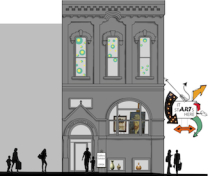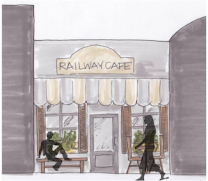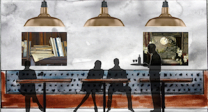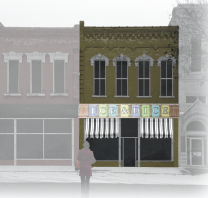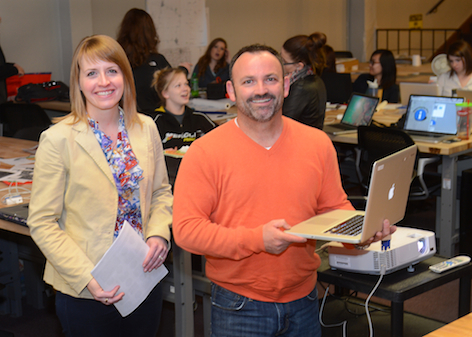
Design students in Lisa Bates' and Tom Neppl's studio developed retail concepts to strengthen southwest Iowa's economy. Photo by Bob Elbert. Larger image.
AMES, Iowa -- Some Iowa State University design students are stepping out of the hypothetical and into the actual in three southwestern Iowa communities.
Working with Clarinda, Red Oak and Shenandoah, 24 students in the senior-level Retail Scapes studio class have developed design concepts to enhance local retail experiences. And what started as individual community storefronts and streetscapes has evolved into a regional vision with connections and collaborations that can strengthen the area's economy.
"These three communities didn't know what they wanted and didn't know how to start. We're the starting point. We're the enabling point," said Interior Design Lecturer Lisa Bates, who teaches the class with Landscape Architecture Lecturer Tom Neppl.
Bates, who splits her time between the classroom and Iowa State University Extension and Outreach, Community and Economic Development, and Neppl developed the class in conjunction with ISU Extension's Iowa Retail Initiative. The retail program connects the university with communities to support Iowa’s independent retailers and revitalize rural downtowns.
"With a class, we only have a semester and can only accomplish so much," Bates said. "Through the IRI, the products at the end of the class can be disseminated. So the ideas, best practices and precedent studies can serve as tools and templates that another town can adapt."
Complex and complementary
Students in the multidisciplinary class major in architecture, interior design and landscape architecture. Many have not worked on projects with students from outside their own major, let alone with communities or clients. Most of their studio design problems have been suppositional, with few constraints that could limit their creativity.
"But real life is complicated and you never know where it's going to go," Bates said.
Since January, the students have made three trips to the communities to learn about the strengths, needs and goals of each. They've engaged in the design process with task forces made up of chamber of commerce leaders, community volunteers, local retailers and others who share a stake in the area's future. And they've learned that the housing, retail, education and recreation in a town or region are intertwined. The quality of one impacts the other, Bates said, and all must be considered together.
"Students are seeing connections for a growing, unified region," Bates said. "They're asking, 'what about this region would attract people from Omaha or Council Bluffs to visit?'"
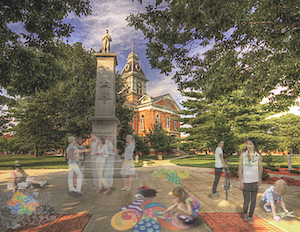
'Harmony in the Heartland' theme reflects region's arts culture.
The students found their answer to that question in each community's rich history, environmental heritage and fine arts culture. Inspired by the region's musical tradition, the class proposed an overarching theme for the region, "Harmony in the Heartland."
"'Harmony in the Heartland' is a perfect theme for the entire region," said Elaine Farwell, executive director of the Clarinda Chamber of Commerce.
Define and design
The Omaha architecture firm Alley, Poyner, Macchietto Architecture sees potential in southwest Iowa. They’ve set up shop in Red Oak, with architects Daric O'Neal and Jason Wheeler dividing their time between the two locations. Wheeler is completing a facade improvement project on 32 buildings around the town square. And he's been an adviser to the students.
"The unique thing about this studio is that the students aren't really given a specific design problem. They're told, 'here's a community with challenges and opportunities and you can do some sort of design intervention,'" Wheeler said. "So they have to develop their own problem and solve it. That forces students to stretch themselves."
The students realize they're having an uncommon studio experience, learning about community dynamics and discovering the potential for their design careers to impact a community. They're learning how to listen to a client, how to read between the lines and how to determine clients' needs without the convenience of a checklist of specifics.
And their design concepts are broad in content. From a regional marketing program that features websites, coupons from across communities and a shared calendar of events ... to a downtown dinner theater for Clarinda's local theater group ... to enhancements that create usable outdoor public space for Red Oak's main square ... to pop-up retail shops for vacant buildings to food co-ops that create a network for locally grown food.
Bike and shop in Shenandoah
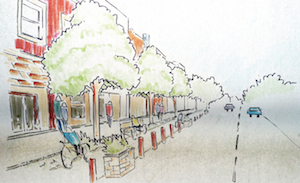
Proposal for Wabash Trace Trail through retail area.
Two landscape architecture seniors, David Anderson from Cambridge, Wis., and Katherine Foerster from Mound, Minn., are taking advantage of one of the region's existing recreational features, the Wabash Trace Nature Trail. Following the former Wabash Railroad corridor, the 63-mile-long trail winds from the outskirts of Council Bluffs southeast to the small town of Blanchard near the Missouri border. It crosses a corner of Shenandoah.
"We want to bring the trail into the community, connect it to the downtown retail area and then to an abandoned mill building," Anderson said. This will make it easier for cyclists in the region to tap into a popular, weekly 14-mile bike ride from Council Bluffs to Silver City, The Taco Ride.
Anderson and Foerster initially envisioned the mill building as a bike rental/sale/repair shop. As the project developed, they added a park with Frisbee golf and a winter ice rink for seasonal activities. The bike shop idea expanded in scope to include additional sporting goods and skating lessons.
An arts hub for Clarinda
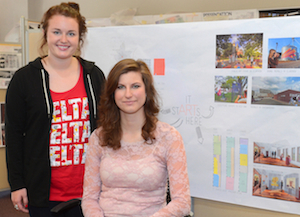
Rokes, left, and Falesch.
Interior design senior Alexis Rokes, Cedar Falls, and Stacy Falesch, architecture senior from Minocqua, Wis., have big plans for renovating the vacant Page County Bank building in Clarinda. They propose converting the historic building into a regional arts center with a gallery, studios for local artists and workshop space for educational programs. They're calling the building "It stARTS here."A vacant lot behind the building would be developed as a sculpture garden. And they've even suggested some ideas for community arts projects for all three towns like murals, sidewalk chalk art and ice sculptures.
A trio of tailor-made cafes
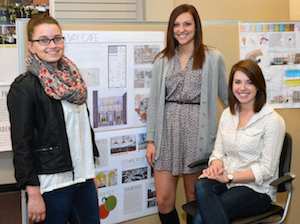
From left, Reiff, Gagnon and Frank.
Architecture senior Bobbi Jo Reiff, Farley, teamed with interior design seniors Shelby Gagnon, Plainfield, Ill., and Gretchen Frank, Mt. Prospect, Ill., to create unique cafes for vacant buildings in each community. Each cafe relates thematically to the region's railroad history and responds to specific community needs, such as a multigenerational gathering place or evening destinations for couples and families. Reiff's concept is a gourmet ice cream shop in Clarinda featuring multigenerational board games. For Shenandoah, Gagnon is proposing a cafe-library with an industrial feel. Frank's idea is a wine tasting/art and music cafe for Red Oak.
A fresh start for the region
"They bring a lot of creativity and a fresh eye to the communities," said Wheeler, their local architect/mentor. "And they've developed some creative and innovative ways to bring some retail opportunities and attention to these three communities."
Wheeler thinks some will be carried forward. "There's a lot of excitement in the towns about what they've developed," he said.
Shelly Smith, marketing director for the Shenandoah Chamber and Industry Association, likes "the out-of-the-box ideas."
"Some of their ideas are obviously beyond reality, but they're ideas that help us see new possibilities. And there are a lot of very practical things that show a new twist on a restaurant, storefront or activities and services that might happen inside," Smith said. “We are looking for ideas to help promote our music history with the Everly Brothers and others. The harmony theme for our towns is a good one.”
Clarinda's Farwell said she's excited with the potential for the students' work, and "extremely impressed" with all the projects because they could be implemented in any of the three communities.
"My goal is to meet with regional chambers, collaborate on the theme and hopefully work from there," Farwell said.
And that's exactly the outcome hoped for.
"We're there to help with ideas," Bates said. "But we can't go with them to the finish line."
